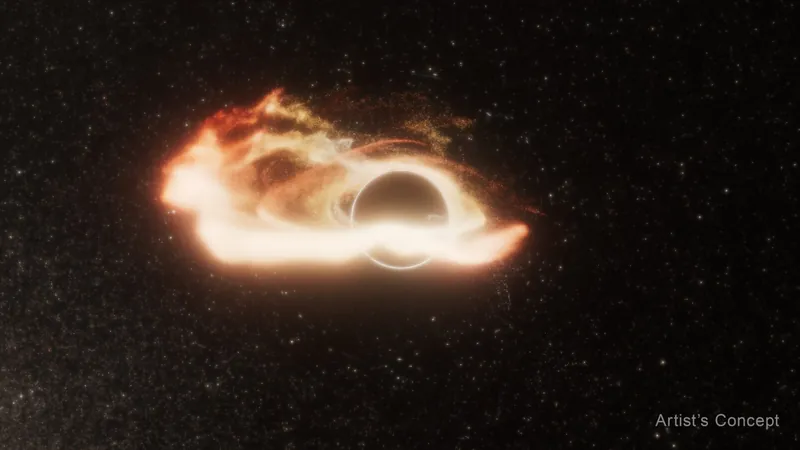
Mysterious Rogue Black Hole Caught Devouring Star From Distant Galaxy!
2025-05-11
Author: Ting
Astronomers Make Shocking Discovery 600 Million Light-Years Away
In a groundbreaking revelation, astronomers have identified a supermassive black hole engaging in a celestial feast, consuming a star from a staggering distance of 600 million light-years away. This astronomical event, ominously named AT2024tvd, was initially detected by the Palomar Observatory’s Zwicky Transient Facility and later confirmed by renowned space telescopes like Hubble and Chandra.
An Unprecedented Location for a Black Hole
What’s astonishing is that this rogue black hole is situated 2,600 light-years away from the center of its host galaxy, diverging from the norm as supermassive black holes typically reside within the galactic core. To put it into perspective, that’s just one-tenth of the distance between our Sun and Sagittarius A*, the black hole at the heart of the Milky Way.
The Cosmic Crime: Spaghettification in Action!
The event represents a tidal disruption event (TDE), a phenomenon where a black hole’s immense gravity tears apart a star. This dramatic process, whimsically dubbed ‘spaghettification’, creates a brief yet intense burst of energy that can shine as brightly as a supernova—the catastrophic end of a massive star. This spectacular display is detectable across various wavelengths of radiation, making TDEs critical for identifying elusive black holes in our universe.
A First in Optical Surveys: Changing Our View of Black Holes
AT2024tvd stands out as the first offset TDE identified through optical surveys, as documented in an upcoming study in The Astrophysical Journal Letters. This discovery hints at the existence of rogue black holes, transiently lit up by their unfortunate stellar snacks, allowing astronomers to explore their mysterious nature.
Theories on How This Rogue Black Hole Came to Be
Researchers speculate on how this rogue black hole became displaced within its galaxy. One theory suggests it originated from a smaller galaxy absorbed by the larger one. Another possibility proposes that it was part of a triad of black holes, ejected from the core by the two larger, more dominant counterparts. Regardless of its origin, one thing is clear: this rogue black hole has a mass around one million solar masses, making it at least ten times lighter than the supermassive entity at the galaxy’s center.
Future Discoveries Await!
With advanced instruments like the Vera Rubin Observatory and the Roman Space Telescope on the horizon, astronomers are excited about the potential for discovering even more rogue black holes scattered throughout the cosmos. The notion of these voracious entities roaming through unexpected regions of space adds an unsettling twist to our understanding of the universe!



 Brasil (PT)
Brasil (PT)
 Canada (EN)
Canada (EN)
 Chile (ES)
Chile (ES)
 Česko (CS)
Česko (CS)
 대한민국 (KO)
대한민국 (KO)
 España (ES)
España (ES)
 France (FR)
France (FR)
 Hong Kong (EN)
Hong Kong (EN)
 Italia (IT)
Italia (IT)
 日本 (JA)
日本 (JA)
 Magyarország (HU)
Magyarország (HU)
 Norge (NO)
Norge (NO)
 Polska (PL)
Polska (PL)
 Schweiz (DE)
Schweiz (DE)
 Singapore (EN)
Singapore (EN)
 Sverige (SV)
Sverige (SV)
 Suomi (FI)
Suomi (FI)
 Türkiye (TR)
Türkiye (TR)
 الإمارات العربية المتحدة (AR)
الإمارات العربية المتحدة (AR)